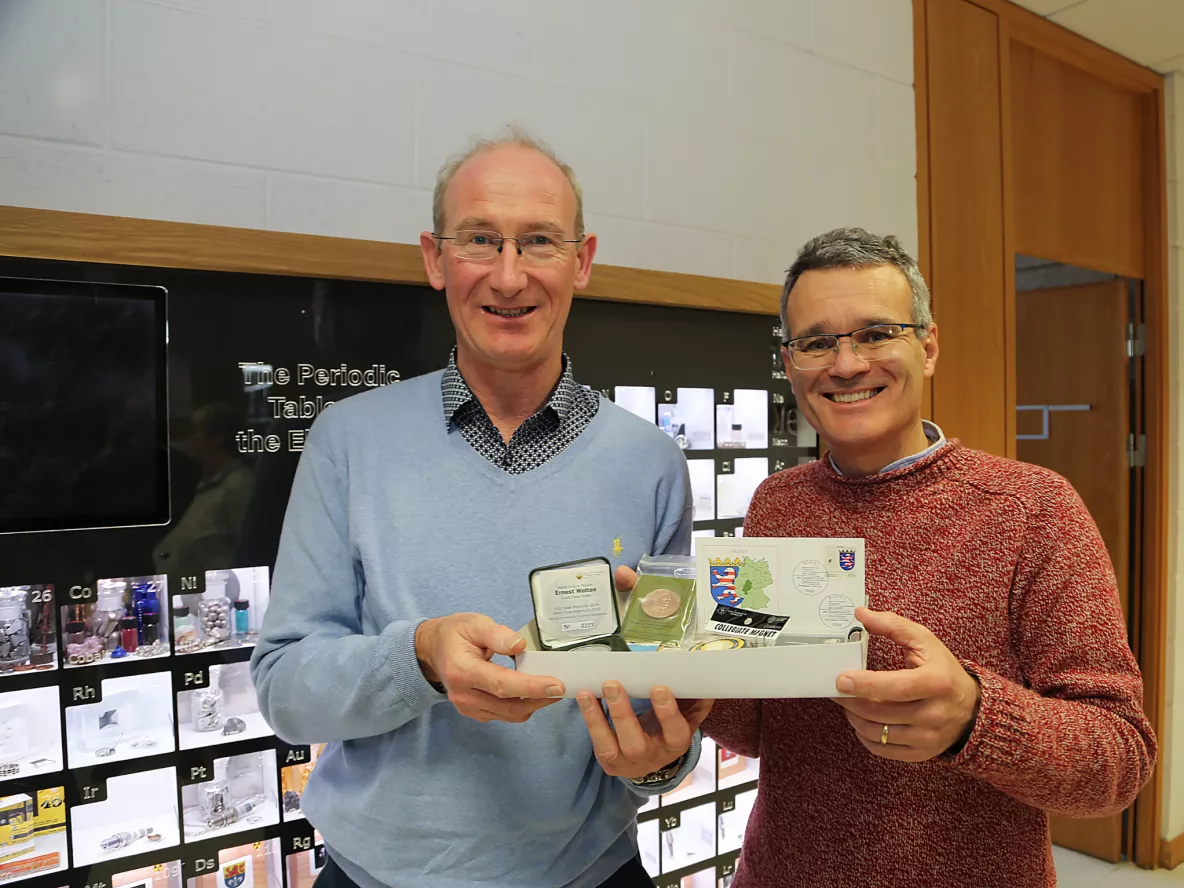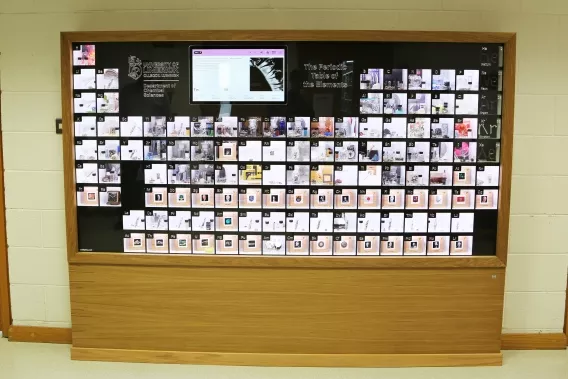

In April 2023, the Department of Chemical Sciences at University of Limerick (UL) in Ireland celebrated the launch of its large-scale, interactive periodic table display – the first of its kind in any third-level institution in Ireland.
The display measuring 2.4 metres wide by 2 metres tall, contains an impressive array of pure element samples (solids, gases and liquids) alongside related minerals, ores, artefacts and everyday items for elements 1 to 92 (hydrogen to uranium). These elements are securely housed within individually lit, encased, 120mm-sided cubes. For elements 93 to 118 (neptunium to oganesson), it was not practical to similarly adorn the cubes due to these elements’ scarcity and radioactive nature. Each of the cubes instead contains a smooth varnished wooden block with a crisp laser-engraved image related to the respective element. For instance, element 99 (einsteinium) displays a black-and-white photo of Albert Einstein, while element 108 (hassium) displays the coat of arms of Hesse in Germany.
An integrated interactive touchscreen displays many interesting facts about each element, as well as descriptions of the contents of each cube and engaging videos of experiments involving the elements. The display was custom-designed, fabricated and installed with great care and attention to detail by a specialist company based in Madrid, Spain. Dr Peter Davern of UL’s Chemical Sciences Department, who is also a UL alumnus, coordinated a fundraiser that helped cover the cost of the display whereby people donated between €50 and €400 to ‘adopt’ an element, allowing them to have a short, personalised inscription laser-engraved on the inside wall of their adopted element’s cube. Many donors used this opportunity to acknowledge family members, classmates, friends, work colleagues and mentors, or remember those who have passed on. Various companies, organisations and institutions also contributed as corporate sponsors, and their logos are prominently displayed on the side panels of the exhibit. The display now serves as a permanent, high-impact attraction to promote science among UL’s undergraduate students, as well as secondary and primary school-goers in mid-west Ireland and beyond.

Among the guests at the display’s launch was Billy Walsh, an enthusiastic supporter of the fundraiser and a member of UL’s Industrial Chemistry Class of 1985. As Billy marvelled at the array of interesting artefacts within the cubes for elements 1 to 92, he wondered whether something could be done to augment and complement the laser-engraved wooden blocks displayed for elements 93 to 118, collectively known as the transuranic elements.
He resolved there and then to champion the cause of the transuranic ‘orphans’ as he called them, and so began his quest to source suitable artefacts for each one. Billy’s journey took him to the far-flung corners of the internet where, after a nine-month odyssey, he had amassed an impressive collection of over 50 orphan-related artefacts from around the world – from New Zealand, the US, Europe, Kazakhstan, Japan, Israel, Russia, and beyond!
Dubbed the ‘Walsh Collection’, it includes stamps (some of which are first-edition covers, like the one commemorating Lise Meitner (element 109, meitnerium), coins (such as a San Marino 200-lira coin commemorating Enrico Fermi, element 100 fermium), and a 1917 10-pfennig coin issued in Darmstadt during World War I (element 110, darmstadtium). Also part of the collection are bank notes (like a 1968 Israeli five Lirot bank note commemorating Albert Einstein), commemorative medals (such as a Royal Society of New Zealand Franklin Bronze Medal commemorating the centenary of Ernest Rutherford’s birth (element 104, rutherfordium) and an old Carlsberg beermat in memory of Niels Bohr’s (element 107, bohrium) association with the Carlsberg brewery in Copenhagen. Billy even sourced two miniature light-up cubes donated by Fr K. Becker of the GSI Helmholtz Centre for Heavy Ion Research in Darmstadt, Germany, commemorating the centre’s discovery of elements 108 (hassium) and 110 (darmstadtium). Along the way, he connected with fellow ‘periodic table travellers’ like Dr Kristin Kirschbaum, who was steadily advancing her own quest to build and populate a large-scale periodic display at the University of Toledo in Ohio.
Ever the Good Samaritan, Billy was quick to support Kristin’s efforts by directing UL’s Peter Davern to forward any ‘Walsh Collection’ artefacts surplus to UL’s periodic table display. The shipment included the two miniature light cubes, which were too large for UL’s display, along with a selection of stamps and coins. In return, Kerstin facilitated a shipment from a US vendor to Peter Davern of four New Mexico stamps signed by Glenn Seaborg, for Peter to add to element 106’s (seaborgium) cube at UL.
So, thanks to Billy Walsh’s boundless energy, effort and all-round enthusiasm, the UL ‘orphans’ are orphans no more, and Kristin Kirschbaum’s periodic table display at UT is a few steps closer to completion.
 Student Centre (SU-101)
Student Centre (SU-101)
University of Limerick
Limerick, Ireland
Phone: 353 61 202475
Email: ulaa@ul.ie